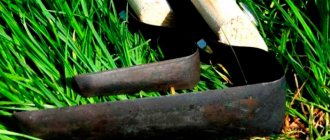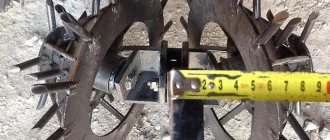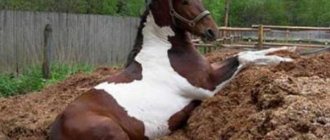Subtleties of choice
When selecting equipment for agricultural work, you must follow a number of rules and pay attention to key details. Features of the choice are as follows:
- the tools must be reliable and sharp;
- the working part must be made of high quality steel;
- It is advisable to choose options in stores with an ergonomic handle, because during work there is constant pressure on the hands; you should choose cuttings from hickory or ash, and the base should be very smooth to prevent hand injuries;
- the nozzle must be cast together with fixing fasteners;
- The thickness of the cutting surface should not be less than 3 mm.
When purchasing a garden tool, it is important to decide on the purpose of its subsequent use. To work between small gaps in beds, you should choose a tool with a narrow blade.
To create a beautiful lawn, you should take a closer look at options with an oval blade shape. If you buy a hoe for hilling or creating furrows, then you should take a closer look at equipment with a semicircular or trapezoidal tip. Such hoes ideally cultivate the soil to a depth of 60–80 mm. For work on clay or rocky soil, you should take a closer look at options with a narrow knife. For soft soils, you can use options with a large working surface.
Important! A properly chosen type of hoe will serve as a faithful assistant for a long time and will delight gardeners with the quality and effective results of their work.
How to choose a good hoe?
A good hoe, or, as people call it, a chopper, is one of the oldest agricultural tools known to mankind, which is useful not only for loosening the soil, but also for hilling up beds or for removing fairly boring weeds. However, the effectiveness of this important garden tool largely depends on how correctly and competently it was chosen. How not to make a mistake with your choice and buy exactly what you need?
Why do you need a hoe?
A hoe is an indispensable assistant for hilling or weeding beds, as well as for creating small rows or holes and for aerating the soil. It looks like a three-sided blade made of steel, into the eye of which a handle located at right angles to the blade is inserted. And you can work on all three sides of it! Essentially, a hoe is a self-sharpening wedge attached to a handle, equipped with sharp cutting edges. And for it to truly be self-sharpening, it must be made of high quality steel!
Penetrating into dense soil depths, the hoe perfectly copes with the difficult task of loosening the top layer of soil and in a matter of minutes forms many furrows, which can later be used to sow seeds in them. And the lightweight models of this tool allow you to easily mow down large weeds without turning over the earthen layers. By the way, the work of well-known cultivators is built exactly on the principle of a hoe!
Types of hoes
There are several types of hoes designed for different purposes. A garden hoe equipped with a wide blade is perfect for hilling up a huge number of plants, and a universal triangular hoe with a solid working surface or its Dutch trapezoidal colleague, which has a special hole for greater ease of the tool, will be a real boon for loosening the soil - the shape of the wedge in the form of a triangle or trapezoid allows enter even the hardest and driest soil without much difficulty. At the same time, wedges with rounded corners will always be characterized by the greatest ease of handling and maximum strength.
What should a good hoe be like?
A good hoe must be durable and perfectly sharpened, and its working surface must be made of the highest quality steel. In addition, it must have an ergonomic handle, since when working with it there is constant pressure on the hand. It is especially good if the handle is made of hickory or ash. And one more important requirement for it is ideal smoothness, eliminating possible injury to the hands.
The head of a truly durable hoe should be a single cast unit along with the fasteners holding it to the handle, and the thickness of its knife should in no case be less than three millimeters. And, of course, when choosing a suitable hoe, it is extremely important to answer the question of what exactly it is needed for. To cultivate small row spacings, it makes sense to purchase a hoe with a strongly elongated narrow blade; to create a lawn, a model with an oval working plane; and if the hoe will be used exclusively for weeding or cutting furrows, it is best to choose an onion hoe with a semicircular tip or a trapezoidal furrow hoe – the blades of such hoes are ideal for processing the top seven to eight centimeters of soil, and it does not matter at all what type of soil the soil will be. At the same time, for other work on rocky or clayey soils, it is better to purchase models with a narrow knife, and for sandy loam, a hoe with a fairly wide working plane is useful.
A correctly chosen hoe will become a reliable assistant for many years and will constantly delight its lucky owners with high quality and impressive functionality!
Sources: https://instrumentn.ru/sadovo-ogorodnyj-razdel/tyapka-naznachenie-vidy-i-vybor https://yes-dacha.ru/140-motyga-kakuyu-vybrat-dlya-legkogo-rytya-arykov -video.html https://7ogorod.ru/prochee/motyga.html https://7dach.ru/NatashaPetrova/inventarizaciya-ot-palki-kopalki-do-kultivatora-motyga-samyy-drevniy-instrument-210414.html https://3vedra.com/sadovyj-inventar/tyapka.html https://www.asienda.ru/sadovyj-inventar-i-instrumenty/kak-vybrat-horoshuyu-motygu/ https://ogorod-bez-hlopot .ru/kak-xranit-cherenki-vinograda.html
Where is it used?
It seems that a hoe for cultivating land is extremely simple. It is often also called a hoe. Due to the varying sizes of plots, many cottage owners need work to be completed quickly. It is very convenient for the garden due to its long handle. Its length should be proportional to the height of its owner. It is very comfortable and versatile. Due to its design, it has a solid working surface.
The variety of hoes means different applications, namely:
- a Dutch tool in a metal mount has a hole, which makes the hoe much lighter, but due to such a hole, the soil is sifted during the process of weeding or hilling;
- For a vegetable garden, a hoe with a wide base is very necessary; if the ground is quite soft, then such a tool is perfect for the garden;
for rocky ground you need a tool with a narrow blade; to remove weeds, you should pay attention to the option with a narrow working surface;
- if desired, you can make some modernization to this hand tool; some engineers suggest making a special bend or a round knob;
- using a hoe it is very easy to clear the path of grass, which is possible thanks to the pointed edges on the sides;
a small format hoe in the form of a plow tine is necessary when loosening the earth, hilling vegetables or collecting weeds with roots; to make a beautiful lawn, you should pay attention to a tool with an oval tip;
A hand tool may have two working ends, but of different shapes and widths. It will help cultivate the soil in the vineyards. The simplicity and ease of such work is ensured by a compact and comfortable handle. Some gardeners can make the tool themselves. To do this, you will need a classic bayonet shovel or a shovel with a rectangular tray. You need to level it and cut it at an angle of 45 degrees, and then sharpen the edges. Due to the heavy handle, the tool will be quite effective.
Small subtleties
Before starting such labor-intensive tasks as weeding, hilling or weed control, it is very important to get the setup correctly and also sharpen the tool well. A sharp hoe makes the job easier, uses less energy and eliminates calluses.
A sharpened hoe has an angle of 45 degrees on its working surface. This procedure should be carried out systematically, otherwise working with the soil will bring you a lot of trouble and turn into hard labor.
When choosing a tool, you should give preference to a lightweight, multifunctional hoe. Pay special attention to the cuttings. It is better to avoid a hoe with an all-metal handle. Although it is very durable, it is very difficult and inconvenient to handle. Such a tool is suitable for people who are not deprived of strength, and only for certain land work.
If you want to spend a minimum of energy, choose the latest invention - an electric hoe-ripper. It performs basic earthworks and does not require additional effort. Its only drawback is its very high price.
Different names - the same essence
By and large, both a hoe and a chopper are all the same tool, which is familiar to everyone and is a triangular, arched or trapezoidal blade attached at an angle to a long wooden handle. With its help, we loosen the soil between plants and eradicate weeds.
Also, a triangular-shaped tool helps to make small furrows for sowing carrots, onions, parsley and many other seeds. The grooves can also be used for irrigation. This tool allows you to hill up plants that are located even at some distance from you - thanks to this, you do not need to stomp around every plant.
And the names are different in each region, the main thing is that the essence is the same. In the arsenal of every experienced gardener there are many hoes and hoes. In some cases, the design of the instruments is different. To store your entire arsenal, it is recommended to build a small tool shed where you can create ideal conditions for storing them.
Popularity of the tool
The most common hoe was among the eastern peoples: Chinese, Vietnamese, Indians. Where the soil was rocky, it took the form of ketmen with a narrow triangular working part. This tool also differed from an ordinary hoe in the heaviness that was needed to break up particularly hard blocks.
Many land works cannot be carried out without the use of a hoe. This includes weeding, loosening, hilling, and making planting ditches. Tillage, which is carried out using this tool, is called hoeing. At the same time, you can weed the beds, hill up the plants and loosen the soil. To cultivate areas of soil between narrow beds, a flat cutter, a special type of hoe, is used.
Double-disc “rawl” for hilling
This device is in no way similar to an ordinary hoe, however, it is a hoe for hilling potatoes and it has a very narrow scope of application. It is used primarily to create a high ridge and shelter potato bushes from frost in the spring or to increase aeration (air exchange) of the soil. You can create such a miracle of a vegetable garden very quickly, and now we will look at the simplest method.
Step 1
Let's create a frame.
To make the base, we will need an axis (10 mm rod) and supports, which will be rods from M 8 reinforcement. The axis is the middle of the structure, two reinforcements will extend from it at an angle of 45 in one direction and 2 in the other. The ends of the fittings are connected to each other by a thick pipe, approximately 25-30 mm in diameter - these will be the 2 handles of our device. The edges of the opposite handles will be connected to each other with a metal square of 15x15 mm, the connecting rods will be welded together every 40-50 centimeters to increase rigidity.
Step 2
We fasten the “wheels”.
Instead of ordinary rubber wheels, which quickly wear out during operation, you can use metal disks. The easiest way to take them is from a disc grain seeder. Every farmer throws out dozens of them every year. It is precisely such “waste” that is suitable for our device; we take it directly with the bearing group. We place it on the conical axis and screw it with a nut. As a result, we will end up with slightly crooked wheels (if they are straight, we need to bend the axle so that the wheels are at an angle of at least 15).
Step 3
We set up a protective zone.
A double-disc rawl should be used by two workers at the same time, since it will be difficult for one person to work. Once you pull it down the row, the discs will form a ridge of soil under the bushes. The closer the disks are to the row, the larger the ridge. It is advisable that they be no closer than 10 centimeters from the stem, so as not to damage the plants. If the ridge is small, you can deepen the disk using a special weight that is hung on the frame reinforcements.
Characteristics of Zholobov's flat cutter
This tool is mainly used to control short and weak weeds. Working with a Zholobov hoe is very simple: the farmer carries out back-and-forth movements, ironing the soil. During this process, the soil is loosened and weeds are removed with a knife. This tool has many advantages:
- cheap and easy to manufacture and use;
- the load is distributed on both hands thanks to the comfortable handle;
- the worker expends less force, in contrast to doing similar work with a hoe;
- high speed;
- the work is performed without significant bending (the spine is straightened).
However, despite this, the tool also has disadvantages. It is heavy (10 kg of iron), can only be used on leveled areas, and working between rows of plants is not convenient. As a result, due to a number of shortcomings, this tool is significantly inferior to hoes and hoes, which makes it less popular among gardeners and gardeners.
Types of hoes - devices for all occasions
Garden hoes have a variety of parameters, because work in the garden is completely different. To process wide row spacing, choose a tool with a wide, massive blade, so that the weeds themselves scatter at the sight of such a formidable tool. For hilling, it is more convenient to work with miniature hoes with a light blade, thanks to which the gardener does not get tired of maneuvering among the tops.
Hoes are made of carbon steel because this material sharpens well
However, it rusts, so after gardening it is important to clean the blade from the soil, lubricate it with oil and store it in a dry place. You can easily make such a tool yourself if you have a welding machine, a sheet of steel and an electric sharpener at hand.
But it will be difficult to make a stainless steel tool yourself, so most often they buy it. Stainless steel simplifies the maintenance of the instrument. It is believed that a forged hoe sharpens better, but in practice the difference is not noticeable. Moreover, there is no point in buying a hoe made of Damascus steel - except as a souvenir, since it is simply a pity to work with such an expensive tool.
In the era of replacing manual labor with mechanical labor, it would be surprising if gardeners did not come up with an option to replace hoes. So, among the motor cultivators, which are quite large and heavy, there is a relatively miniature tool - an electric hoe. Its light weight allows you to easily handle the tool during work.
How to choose a hoe: types of tools and recommendations
A hoe is a universal garden tool necessary for loosening the soil between plantings. It makes it easy to weed beds, remove weeds and unnecessary roots. The equipment is suitable for making holes in the soil for planting seeds and helps hill up potatoes and other crops. You can loosen the soil near the bushes with it, saturating the soil with oxygen, or make holes for watering.
This useful and at the same time simple device has been known since ancient times. The hoe consists of a handle (handle) and a shovel. The shovel is an iron sheet that is attached to the handle at an angle of 70 to 90 degrees. Most often it is made in the shape of a trapezoid. It can also be triangular or rectangular.
Almost everyone has a hoe at their dacha. This is an indispensable tool when working with the earth. Experienced gardeners may have several varieties in their arsenal.
Types and differences
There are several classic types of hoes. They differ in the length of the handle and the shape of the blade.
- Hoe. Another name for sapka. It has a semicircular blade with pointed ends.
- Hoe. This is a miniature hoe. The tool has a small handle and a shovel.
- Ripper. It has a short handle, and instead of a shovel there is a small trident.
- Electric hoe. This is a type of motor cultivator. There are two types: battery-powered and plug-in powered.
- Fokina flat cutter. This is a new invention. Another name for the device is the Fokin manual tillage implement. On the long wooden handle there is a sharp narrow blade, curved in several places at once.
In stores you can find a huge selection of hoes. In addition to the classic types, there are a variety of unusual devices for loosening the soil on sale. Among them are furrows, weeders, drag hoes, ax hoes, etc.
Recommendations when choosing a model
A person who is puzzled by the purchase of this garden tool for the first time may be confused. To prevent this from happening, you need to understand why you are buying a hoe. Each model is designed for a specific type of work.
The usual one is intended for loosening, weeding, and creating holes.
A hoe is suitable for hilling potatoes. Thanks to its long handle, you don’t have to bend over to the ground, and you can also hill up even in hard-to-reach places.
To weed, you should use a small, light, serrated hoe.
If you plan to process wide row spacing, then it is better to purchase a hoe with a long handle and a wide blade.
In plantings located close to each other, it is best to use a hoe. A small tool will loosen the soil without cutting the plants or damaging the root systems.
You can buy a ripper if there is a need not only to break up clods of earth, but also to remove the roots of creeping weeds.
People who are accustomed to using mechanical tools will appreciate an electric hoe. She will do everything in the garden herself: loosen and plow the soil, remove the weeds, trim the flower beds.
It is worth knowing that an electric chopper that runs on a battery is more expensive.
Fokin’s model will be needed by gardeners who plan to level the surface of beds, engage in slicing (deep cutting) of the soil, and cultivate clay soil. This equipment is suitable for regular loosening and weeding of beds.
How to choose a comfortable hoe
In order to choose a convenient tool, you need to consider some points. When purchasing, it is recommended to pay attention to the material of the shovel. It is made from carbon steel and stainless steel. Both options have their pros and cons.
The carbon steel blade is easy to sharpen. But the material rusts too quickly. In order for such a slipper to last as long as possible, after excavation work it must be cleaned and lubricated with oil. Store in a dry place.
A stainless steel hoe does not require special care. The disadvantage of this tool is its high cost.
When choosing convenient models, you should pay attention not only to the material of the blade, but also to its thickness. The ideal thickness is 1-2mm. Exactly the same as a garden saw. It is more comfortable to work with a sharp tool.
In stores you can find hoes with 10mm blades. This tool is not suitable for loosening the soil.
When purchasing any model, you need to pay attention to its weight. The lighter the hoe, the easier it is to handle.
It is important how the instrument fits in your hand, whether it is comfortable to hold. Nowadays, stores sell products with curved handles - according to reviews, working with them reduces tension in the back, but this is all individual and must be experienced for yourself.
The handle can be made not only of wood, but also of plastic, aluminum, and metal. It is better to abandon the all-metal handle. This tool is durable, but too heavy.
The thickness of the cutting must also be taken into account. It shouldn't be too thick or too thin.
Practical use of the hoe
Despite the availability of a large amount of modern equipment in stores, many agricultural households, and especially summer residents, continue to use a hoe. This is explained by the fact that this tool can be purchased at an affordable price or even built with your own hands (more on this below), which cannot be said about new units. In addition, if a hoe is used correctly (as a hoe is most often called in Russia), the work does not bring discomfort, does not require much time and, most importantly, effort.
Hoe
To make it comfortable to work with a hoe, first of all you need to pay attention to the handle. It must match the physique of the person who will use it to work in the garden
You also need to remember that hoes have different purposes, and they are all designed for specific jobs.
Important! Most often, summer residents purchase universal hoes that have a continuous working surface. The so-called Dutch model is much better designed
Its main difference from the universal hoe is that it has one hole in the working surface. It is intended to lighten the entire structure. In addition, the soil is sifted when processed with such a hoe.
The so-called Dutch model is much better designed. Its main difference from the universal hoe is that it has one hole in the working surface. It is intended to lighten the entire structure. In addition, the soil is sifted when processed with such a hoe.
In the garden, it is best to use a wide garden hoe. It fits well and is very convenient for hilling rows. Experts advise using this tool with a wide blade on sandy loam soils, and, on the contrary, with a narrow blade on heavy or rocky soil.
Hoe
There are also convenient hoes for garden work. Many summer residents, due to a lack of land, plant the plant very densely, which creates some problems during weeding and loosening. This is where narrow and elongated hoes can come to the rescue. They easily and quickly remove weeds, loosen the soil and at the same time, due to their size and shape, do not affect the cultivated plants growing on the site.
Summer residents can also change the tool themselves. For example, with your own hands you can make the necessary and convenient bend or a round knob at the end of the hoe.
Division of labor and development of new crafts in prehistory
Other types of rocks (granite, jade, etc.) began to be used to make tools, and they also switched to the deliberate extraction of stone from the bowels of the earth.
The development of mining was also facilitated by the fact that unweathered flint, mined from underground, when making tools from it, had better qualities than weathered flint found on the surface.
All this led to the fact that for the extraction of flint they began to construct primitive mine shafts that passed through alluvial rocks and thin layers of sand with a low flint content to the layers richest in flint.
The growing need for tools forced individual members of the clan community to engage only in the extraction of stone raw materials and the manufacture of various tools from them. In this regard, in the settlements of Neolithic people, unique workshops for the manufacture of tools and weapons appeared.
Other branches of production of material goods (production of housing, pottery, clothing, etc.) also received higher development. Moreover, they had a significant impact on the expansion of existing sectors of the economy and contributed to the emergence of new industries (for example, primitive textiles), caused by the ever-growing needs of people.
0
Related publications:
- The simplest tools of ancient people
- Housing construction and apartment renovation in the USSR
- Discovery of fire by primitive people
Author of the publication
offline for 2 weeks
Weed control stirrup
Another very interesting device for quickly and effectively removing weeds from the area. It is a metal square welded from 4 metal strips, 2 of which are reinforcement supports, 1 is a blade for cutting weeds, 1 is attached to a pipe with a handle. To make such a cutting for the front garden yourself, you need to do the following.
- We take a strong metal strip made of high-density steel and bend it into a square. Its length should be 60 centimeters, width – 3-5 centimeters. The side supports will be 10 centimeters each, the blade and fastening will be 20 centimeters each.
- We weld one of the large sides to the pipe into which the handle will be installed, at an angle of 30-45. We make the opposite side with a blade - we sharpen it, and as best as possible, because the essence of this tool is not to hit tough weeds, but to destroy small herbaceous plants in the upper layer of the earth.
- We weld small oblique reinforcements. Metal inserts between the fastening side and the side reinforcements will significantly increase the strength of our product.
Now you have an excellent item that will help you get rid of overgrowth in your front garden in a few minutes and easily cut off all the weeds in the garden bed. Frequent maintenance of the area is expected, since using a stirrup against weeds above 15-20 centimeters will be ineffective.
Hoe and hoe - a type of chopper
A hoe, also known as a hoe, differs from a chopper in that it has a semicircular blade with pointed ends. A hoe is convenient for knocking out holes and rows in the ground for planting potatoes, as well as fighting particularly established weeds. There is also a hoe - a smaller copy of a hoe with a small handle. This tool is easy to use with one hand. Due to its small blade and control over the force, the hoe is very useful when hilling plants in dense plantings, when there is a high probability of cutting roots and stems.
The Fokina hand hoe, or Fokina flat cutter, is a relatively new tool promoted by supporters of natural farming, without plowing and deep processing. In appearance, this is a sharp blade located on the handle in such a way that the gardener can cut weeds without penetrating deep into the ground.
- Author: Mikhail Malofeev
Rate this article:
- 5
- 4
- 3
- 2
- 1
(10 votes, average: 4.2 out of 5)
Share with your friends!
Types of guns
Tools for gardening differ in appearance and have their own design features. Types of hoes:
- Sapka (sapa). It is equipped with a shortened handle and a spatula, the sharp part of which is about 12 cm. Such a tool is convenient not only to fight weeds, but also to make depressions in the beds.
- Garden hoe. Consists of a rectangular tip and a long handle. It is used when weeding the garden and trimming the roots of the plant.
- Hoe. It has a massive working part: long, high, with a wide blade. Suitable for working with soft and hard soil.
- Manual ripper. Instead of a shovel, it has teeth for cultivating the soil. Depending on the number of cloves, the device comes in different sizes.
- Two-way device. It is a symbiosis of a hoe and a rake. The product is used to sow various crops.
- Electric hoe. It is an agricultural machine that runs on mains power or a battery. Consists of a telescopic rod with 2 handles and an attachment with sharp moving knives.
Tools for gardening differ in appearance and have their own design features (Photo used under standard license ogorodnye-shpargalki.ru)
Product care
In order for the hoe to serve well, the tip should be sharpened at the beginning of each season.
Process description:
- prepare a medium grain block;
- moisten it with machine oil;
- run several times along the edge of the blade away from you.
When purchasing, it is important to check the reliability of the product: the tip must be firmly fixed, and the handle must not have cracks or roughness. For better preservation, the weapon should be kept in a dark, dry room.
In different regions, hoes are called differently. Regardless of the type and name, every gardener needs these tools on the farm.
Do you have a hoe, hoe and hoe available?
The original article
and other materials can be found on our website .
You can read about the drip irrigation hose in the following article:
Stone age ax
The axe, which appeared in the early Neolithic, was invaluable in the construction of huts and huts, but it was especially important for the production of boats - dugout canoes. Initially, the ax was made from a triangular flake of flint. Its length reached 10-15 cm. The working part of the ax was a wide, beveled blade, initially formed not by grinding, but by a chip received from a blow from the side with a chipper.
First, the stone blade was fixed in the split end of a wooden handle. The use of the handle has played a big role in increasing human efficiency.
Long-term use of a stone ax showed that it could not produce the desired effect when splitting and therefore left ragged, somewhat convex cutting marks. In addition, working with an ax required a lot of energy. In an effort to make their work easier, people began to more carefully finish the ax blade. Through long experience, grinding and polishing techniques were mastered, for which a primitive grinding device was subsequently invented.
The efficiency of Neolithic axes with handles was 0.78-0.89, i.e. was no lower than the efficiency of modern hand tools.
Practical advice on choosing hoes
The most practical equipment will be made from stainless steel. You don’t need to take care of such a glanders, but there is one drawback - the price is steep. Cheaper hoes are made from steel containing carbon. Steel is easy to sharpen, but it quickly rusts if not handled correctly. After work, steel hoes must be cleaned, lubricated and stored in a dry place.
The smaller the weight of the hoe, the easier it will be to use.
Regarding the handle, traditional wooden handles will be the most convenient. Some people prefer plastic or aluminum cuttings. However, they can bend, unable to withstand the “fight” with a particularly overgrown weed. But it is better to avoid metal cuttings - they are too heavy, although they are the most durable.
The longer the cutting, the less strain on your back will be when processing large areas. But you need to focus on your height - a handle that is too long will only get in the way. For removing weeds in compact flowerbeds planted with flowers, a hoe with a short handle is more suitable.
What is the difference between a hoe and a hoe and a flat cutter?
All three tools are widely used in agriculture, but they all have a different working surface shape, which ultimately creates different movements during soil cultivation.
Important! It is the hoe that is considered the best tool among all three of the above.
For example, using a flat cutter instead of a hoe will be ineffective, since only a hoe can cope with tidying up an abandoned area that, for example, is overgrown with weeds. A hoe or hoe allows you to better destroy weeds on paths and between plants. It is also suitable for destroying raspberries, blackberries, raspberries, and cherries.
A hoe or hoe allows you to better destroy weeds
In turn, the Fokina flat cutter is used mainly to combat young and weak weeds. And a hoe is a tool that is only suitable for hilling potatoes, tomatoes or for creating ridges and sides. In some cases, summer residents use hoes to weed the garden, but this is not as effective as working with a hoe.
How to sharpen a hoe
Many gardeners are interested in how to properly sharpen a hoe (hoe). This should be done at least once a season for prevention purposes. To sharpen a tool, you need to know what a hoe is and how it works. In this case, as a rule, a coarse-grained block is used. It is carried along the very edge of the blade, maintaining an angle of 8°. Before sharpening, the sharpener is moistened with water.
Additional Information! You can also coat it with machine oil.
Sharpen the hoe from the center to the corners. A well-sharpened hoe will be sharp and shiny, but the edges should not be very sharp. Don't worry if they become very sharp, as after a few days of active work they will become a little dull.
Every gardener has a classic hoe. It faithfully and faithfully serves for years without requiring maintenance like a motorcycle or electric chopper. It only needs to be sharpened periodically and stored properly in winter so that it does not become dull. It costs pennies, and if they don’t exist, then you can make the tool yourself. Isn't it a miracle thing?
https://stroy-podskazka.ru/motygi/vse/https://glav-dacha.ru/vidy-tyapok-dlya-propolki/https://7ogorod.ru/prochee/motyga.html
Excerpt characterizing the Hoe
“I don’t know if they’ll allow it,” the officer said in a weak voice. “There’s the chief... ask,” and he pointed to the fat major, who was walking back down the street along a row of carts. Natasha looked into the face of the wounded officer with frightened eyes and immediately went to meet the major. – Can the wounded stay in our house? – she asked. The major put his hand to the visor with a smile. - Whom do you want, mamzel? He said, narrowing his eyes and smiling. Natasha calmly repeated her question, and her face and whole manner, despite the fact that she continued to hold her handkerchief by the ends, were so serious that the major stopped smiling and, at first thinking, as if asking himself to what extent this was possible, answered her in the affirmative. “Oh, yes, why, it’s possible,” he said. Natasha slightly bowed her head and quickly walked back to Mavra Kuzminishna, who was standing over the officer and talking to him with pitiful sympathy. - It’s possible, he said, it’s possible! – Natasha said in a whisper. An officer in a wagon turned into the Rostovs' yard, and dozens of carts with the wounded began, at the invitation of city residents, to turn into the courtyards and drive up to the entrances of the houses on Povarskaya Street. Natasha apparently benefited from these relationships with new people, outside the usual conditions of life. She, together with Mavra Kuzminishna, tried to bring as many wounded as possible into her yard. “We still need to report to dad,” said Mavra Kuzminishna. - Nothing, nothing, doesn’t it matter! For one day we will move to the living room. We can give them all our half. - Well, you, young lady, will come up with it! Yes, even to the outbuilding, to the bachelor, to the nanny, and then you need to ask. - Well, I'll ask. Natasha ran into the house and tiptoed through the half-open door of the sofa, from which there was a smell of vinegar and Hoffmann's drops. -Are you sleeping, mom? - Oh, what a dream! - said the countess, who had just dozed off, waking up. “Mom, darling,” said Natasha, kneeling in front of her mother and putting her face close to hers. “I’m sorry, I’m sorry, I never will, I woke you up.” Mavra Kuzminishna sent me, they brought the wounded here, officers, if you please? And they have nowhere to go; I know that you will allow...” she said quickly, without taking a breath. - Which officers? Who did they bring? “I don’t understand anything,” said the Countess. Natasha laughed, the Countess also smiled faintly. – I knew that you would allow... so I’ll say so. - And Natasha, kissing her mother, got up and went to the door. In the hall she met her father, who had returned home with bad news. - We've finished it! – the count said with involuntary annoyance. – And the club is closed, and the police come out. - Dad, is it okay that I invited the wounded into the house? – Natasha told him. “Of course, nothing,” the count said absently. “That’s not the point, but now I ask you not to worry about trifles, but to help pack and go, go, go tomorrow...” And the count conveyed the same order to the butler and the people. During dinner, Petya returned and told him his news. He said that today the people were dismantling weapons in the Kremlin, that although Rostopchin’s poster said that he would shout the cry in two days, but that an order had probably been made that tomorrow all the people would go to the Three Mountains with weapons, and what was there there will be a big battle. The countess looked with timid horror at the cheerful, heated face of her son while he said this. She knew that if she said the word that she was asking Petya not to go to this battle (she knew that he was rejoicing at this upcoming battle), then he would say something about men, about honor, about the fatherland - something like that senseless, masculine, stubborn, which cannot be objected to, and the matter will be ruined, and therefore, hoping to arrange it so that she could leave before that and take Petya with her as a protector and patron, she did not say anything to Petya, and after dinner she called the count and with tears she begged him to take her away as soon as possible, that same night, if possible. With a feminine, involuntary cunning of love, she, who had hitherto shown complete fearlessness, said that she would die of fear if they did not leave that night. She, without pretending, was now afraid of everything. M me Schoss, who went to see her daughter, further increased the Countess’s fear with stories of what she saw on Myasnitskaya Street in the drinking establishment. Returning along the street, she could not get home from the drunken crowd of people raging near the office. She took a cab and drove around the lane home; and the driver told her that people were breaking barrels in the drinking establishment, which was so ordered. After dinner, everyone in the Rostov family set about packing their things and preparing for departure with enthusiastic haste. The old count, suddenly getting down to business, continued walking from the yard to the house and back after dinner, stupidly shouting at the hurrying people and hurrying them even more. Petya gave orders in the yard. Sonya did not know what to do under the influence of the count’s contradictory orders, and was completely at a loss. People ran around the rooms and courtyard, shouting, arguing and making noise. Natasha, with her characteristic passion in everything, suddenly also got down to business. At first, her intervention in the bedtime business was met with disbelief. Everyone expected a joke from her and did not want to listen to her; but she persistently and passionately demanded obedience, became angry, almost cried that they did not listen to her, and finally achieved that they believed in her. Her first feat, which cost her enormous effort and gave her power, was laying carpets. The count had expensive gobelins and Persian carpets in his house. When Natasha got down to business, there were two open drawers in the hall: one almost filled to the top with porcelain, the other with carpets. There was still a lot of porcelain laid out on the tables and everything was still being brought from the pantry. It was necessary to start a new, third box, and people followed it. “Sonya, wait, we’ll arrange everything like this,” Natasha said. “You can’t, young lady, we already tried,” said the barmaid. - No, wait, please. – And Natasha began to take out dishes and plates wrapped in paper from the drawer. “The dishes should be here, in the carpets,” she said. “And God forbid that the carpets be spread out into three boxes,” said the barman. - Yes, wait, please. – And Natasha quickly, deftly began to take it apart. “It’s not necessary,” she said about Kyiv plates, “yes, it’s for carpets,” she said about Saxon dishes. - Leave it alone, Natasha; “Okay, that’s enough, we’ll put him to bed,” Sonya said reproachfully. - Eh, young lady! - said the butler. But Natasha didn’t give up, threw out all the things and quickly started packing again, deciding that there was no need to take the bad home carpets and extra dishes at all. When everything was taken out, they began to put it away again. And indeed, having thrown out almost everything cheap, what was not worth taking with us, everything valuable was put into two boxes. Only the lid of the carpet box did not close. It was possible to take out a few things, but Natasha wanted to insist on her own. She stacked, rearranged, pressed, forced the barman and Petya, whom she carried along with her into the work of packing, to press the lid and made desperate efforts herself. “Come on, Natasha,” Sonya told her. “I see you’re right, but take out the top one.” “I don’t want to,” Natasha shouted, holding her loose hair over her sweaty face with one hand and pressing the carpets with the other. - Yes, press, Petka, press! Vasilich, press! - she shouted. The carpets pressed and the lid closed. Natasha, clapping her hands, squealed with joy, and tears flowed from her eyes. But it only lasted for a second. She immediately set to work on another matter, and they completely believed her, and the count was not angry when they told him that Natalya Ilyinishna had canceled his order, and the servants came to Natasha to ask: should the cart be tied up or not and is it sufficiently imposed? The matter progressed thanks to Natasha’s orders: unnecessary things were left behind and the most expensive ones were packed in the closest possible way. But no matter how hard all the people worked, by late night not everything could be packed. The Countess fell asleep, and the Count, postponing his departure until the morning, went to bed. Sonya and Natasha slept without undressing in the sofa room. That night, another wounded man was transported through Povarskaya, and Mavra Kuzminishna, who was standing at the gate, turned him towards the Rostovs. This wounded man, according to Mavra Kuzminishna, was a very significant person. He was carried in a carriage, completely covered with an apron and with the top down. An old man, a venerable valet, sat on the box with the cab driver. A doctor and two soldiers were riding in the cart behind.
Hoe
By attaching a handle to a pointed stick, a person received a more convenient and effective tool - a hoe. Its long lever handle increases the force exerted by a person.
Ancient hoes. Photo from the site rubus-idaeus.ru
Several varieties with a similar appearance have appeared. The pick (or pick) had a pointed, beak-like, one- or two-sided working part. A hoe is a blade of various shapes and widths on a handle, and a tool that combines these 2 options is a pickaxe (a blade on one side and a striking “beak” on the other).
Pickax
A pickaxe and a pickaxe are, rather, tools of builders and miners: they are adapted for rocky and very dense soil. Peasants prefer to use a hoe, also known as a hoe, weeder, tsapka, sapka, polotik, kuva, ketmen.
The hoe is the most common and international agricultural tool. Scenes depicting peasants with tools resembling a common hoe can be found in Egyptian pyramids and in ancient frescoes, in Japanese prints and medieval manuscripts. The ancient Sumerians believed that the laurels of the inventor of the hoe belonged to the supreme deity Enlil.
Monument to ketmen in Chon-Kemin. Photo from argumenti.kg
The hoe is depicted on coats of arms (Angola, Mozambique, Tanzania, Zimbabwe), and in Kyrgyzstan, in Chon-Kemin, a monument to the ketmen was erected. This invention turned out to be so successful that, having appeared in the Mesolithic era, it has not only survived to this day with virtually no special changes, but continues to be actively used.
There are different types of choppers
Miracle hoe for easy weeding
Neumann's Miracle Hoe is a relatively recent invention. The working part is made in the form of two springy metal rods, between which a string is stretched (performs the function of a cutting edge). It is fixed in the locking grooves.
Video about what Neumann's Miracle Hoe is and how to work.
The tool is convenient because it allows you to vary the width of the working part. To do this, the string is removed from the grooves, the spring rods are brought together or opened to the required distance, and a new string of suitable size is inserted into the locking grooves. This tool is not suitable for dense soil. The string will have to be changed frequently, the quality of the soil treatment will be worse.
Advantages
The most versatile tool for cultivating soil with your own hands is, of course, a hoe. Made from super hardened steel, it is great for working on heavy soils. The edges sharpened on all sides give it a huge advantage over other tools. The Dutch and ordinary hoe have the shape of a trapezoid. The wedge shape allows it to easily enter even dry, hard soil and loosen it.
Due to the fact that the two sides of the wedge are sharpened and can be used as cutting planes, the hoe weeds well. To loosen the soil, similarly, the tool is rotated in different directions depending on the convenient work option. It is advisable to use a hoe as a flat cutter if the soil in the beds is loose enough. The tool is very sharp and can cut through thick roots; additional sharpening is possible for a straight edge.
What is a hoe
This popular garden tool is a self-sharpening wedge with cutting edges. The hoe is easy to use, since all 3 sides of it take part in the work at once. The tip of the tool penetrates well even into very dense and heavy soil, loosening the top layer of soil and at the same time forming grooves into which seeds are sown during spring tillage. Using a hoe, you can also mow grass, which is quite large in size. However, during this work the layer of earth does not turn over, unlike if this procedure is done using a cultivator.
Hoe
For your information! With the development of technology, the principle of the hoe was used during the development of the cultivator. In other words, it can be called a modern or electric hoe.
Types of hoes, their prices
Depending on the design features, all choppers are divided into the following types:
Garden hoe
A tool with a long handle and a wide blade located at a right angle to the handle.
The classic tool copes well with garden tasks, but its main purpose is weeding and weed removal.
In a standard garden hoe, the crown (similar to a shovel) is connected to the blade by means of a bow or two curved rigid rods using rivets or welding.
The self-sharpening hoe, the blade of which is made of two layers: hard and soft, has become widespread.
The last layer, being gradually erased during operation, leaves a hard layer, thereby maintaining the sharpness of the cutting edge.
It is allowed to edit such a blade with an abrasive wheel.
It will cost the buyer 500 – 1500 rubles.
Sapka
It has a semicircular blade, pointed at the end, that can cope with rooted weeds.
Using this tool, it is convenient to knock out holes in the ground, for example, for planting potatoes.
Some summer residents call this variant motyka, which is also true and is a trace of the Old Russian language in modern times.
The blade, which is called a spatula or shovel, can be attached to the handle in two ways: through a crown located in the upper end part, or through an eyelet deployed perpendicular to the blade.
hoe
A miniature hoe with a small shovel and a handle.
Convenient when working in confined spaces, in cases where high accuracy and precision are required, or where a full-size version of the tool cannot be used.
This mini hoe is indispensable for flower growers.
It will cost 80 – 200 rubles.
Double-sided chopper
Typically a hoe with two shovels of different configurations, located either perpendicular to each other or opposite each other, on opposite sides relative to the eye.
A striking example is the symbiosis of a hoe and a ripper, which is sometimes called a hoe-rake.
On one side of this design there is a shovel, and on the opposite side there is a trident.
This is the so-called planting hoe, the small size of which allows it to be used outdoors and indoors for cultivation, sowing, weeding and, in fact, planting.
Another name is a combination hoe.
Ripper (ripper)
A hoe, in which the place of a shovel is taken by a small trident, intended for loosening and aerating the soil.
Types of hoes
The working blade of a classic universal hoe is made in the shape of a trapezoid, the wide edge of which is the cutting edge.
To make soil cultivation easier, you can use several more types of tools:
- hoe - a semicircular cutting edge (in the form of a halberd);
- drop-shaped, wedge-shaped working blades, well suited for harrowing or processing dense soils;
- Dutch - with a hole in the canvas;
- weeder - in the form of a pitchfork. The roots of the weeds are not cut, they turn outward.
To break up clods of earth, it is convenient to use a “dragon” type hoe, which instead of a blade has a powerful trident surrounded by a pointed bracket.
For loosening and weeding, some summer residents use electric hoes (rotary). They are convenient for weeding soft soil, picking moss from the lawn, and mixing fertilizers.











